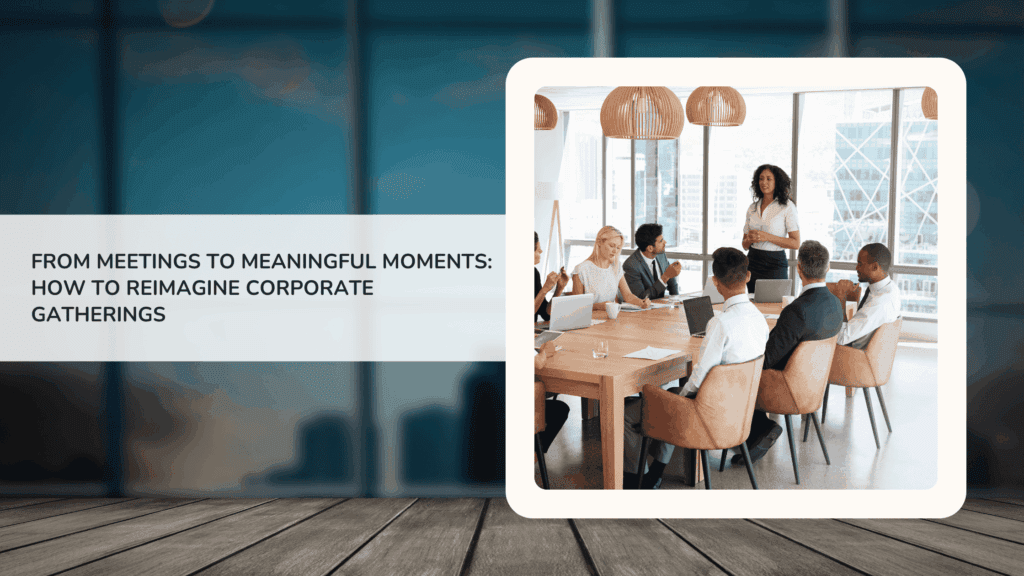Picture this. You introduce a new AI-powered CRM system in your sales team. The younger staffers jump in through a trial-and-error approach (and perhaps a YouTube tutorial) immediately. But your older coworkers prefer a printed, step-by-step walkthrough and require more time to grasp it.
It’s only one of the possible scenarios of a visible skill divide in a multigenerational company with employee birth year ranges:
- Baby Boomers: 1946–1964
- Generation X (Gen X): 1965–1980
- Millennials (Generation Y): 1981–1996
- Generation Z (aka Gen Z, which already accounts for 27% of the workforce): 1997–2012
How should you train and grow such a cross-generational team to make age diversity their performance fuel, not a jam?
This article explains how you can use collaborative training in professional development to bridge the skills gap between employees of different ages in your team.
So, let’s understand the generational fracture and then patch it reliably and permanently—with collective learning sessions as duct tape.
Table of Contents
- Cross-Generational Skill Gaps in the Workplace—What Is Missing and How to Fill Them In
- Expert Strategies for Using Group Training to Close the Generational Skills Divide
- Set Up an Intergenerational Learning Program
- Create a Safe and Inclusive Space with Supportive Atmosphere for Collaborative Training
- Brainstorm Appropriate Learning Activities Together
- Incorporate Reverse Mentorship into Your Training Routine
- Pair Age-Diverse Team Members to Communicate and Solve Problems
- Build a Learning Bridge Between Employee Generations with Outback
- Author Bio
Cross-Generational Skill Gaps in the Workplace—What Is Missing and How to Fill Them In
Communicative
The generational divide at work often starts with the so-called “language gap” in internal communications. Sometimes, employees from different age cohorts have to “interpret” what their colleagues are saying because they are speaking diverse “languages.”
For example:
Take the Millennial and Generation Z slang phrases to indicate that something is really good: “That’s fire!” vs. “That’s bussin’!”
Then, there may be discrepancies in the networking etiquette: more formality for Boomers and Gen X vs. more informality for Millennials and Gen Z. For instance, 80% of Millennials, compared to 60% of Gen X-ers, agree that informal messages with emojis and GIFs help them connect more effectively in a remote or hybrid work environment.
How to bridge this cross-generational skill gap with collaborative learning:
- Clear Communication Training → Teach your team members to express their thoughts clearly and adequately for every age group to understand.
- Intergenerational Etiquette Workshop → Learn to communicate with respect to each other’s personal and professional boundaries.
Cultural/Historical
Culture and history lie in the background (literally!) of another cross-generational skills gap.
In fact, when it comes to hiring, one-third of HR managers are biased against Gen Z candidates and those aged 60 and above, discounting their abilities and experiences.
But then, age discrimination (ageism) may take root in the very work process. As Emily Ruby, Owner of Abogada De Lesiones, puts it, “Even tiny cultural misunderstandings between age-diverse employees may plant the seeds of the ‘us versus them’ mentality with constant toxicity and aggression in the workplace. As a result, this threatens to dent not only the atmosphere but also the overall team’s performance with workplace conflicts or even accidents and injuries.”
That’s when a simple phrase, “You’re too old to understand this tech,” or “You weren’t even born when I/we did this,” may easily convert into a negative altercation.
How to bridge this cross-generational skill gap with collaborative learning:
- DEI Training → Get rid of unconscious bias and stereotypes about people of different ages.
- Culture Training → Discover more about cultures and lifestyles in the 1950s, 1960s, 1970s, 1980s, and so on.
- Conflict Resolution Training → Prioritize it for employees who don’t get along due to diverse cultural perceptions and backgrounds.
Digital
“The Meta-what?”
That’s how a Boomer may react to a Gen Z or Millennial worker mentioning the Metaverse, one of the most revolutionary tech tools these days.
Born into the era of digitalization and social media “tiktoking” their way into their lives, younger generations are objectively more tech-savvy, boasting 60% higher levels of online literacy than Gen X-ers and Boomers.
So, there’s a huge generational gap in digital dexterity and awareness of innovative technologies like these:
- Social media platforms like Instagram or TikTok
- Virtual collaboration tools
- Artificial intelligence (AI)
- Augment + virtual reality (AR + VR)
- The Metaverse
- The Internet of Things (IoT)
- And more!
Note: You can actually organize collaborative learning in the Metaverse (only after explaining this concept and teaching how to enter and browse this virtual world).
For example:
Accenture onboarded and trained over 175,000+ employees of different ages in One Accenture Park, a mixed reality space.
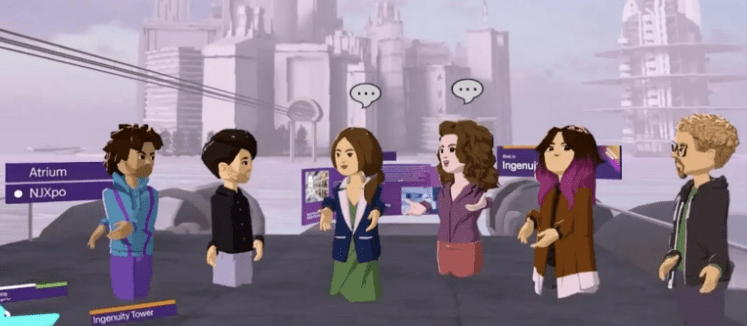
How to bridge this cross-generational skill gap with collaborative learning:
Technology-Oriented Training → Grab a firm digital hold of various tech skills together.
For example:
Learn to run effective meetings via video-conferencing tools so that everyone is on the same virtual page, especially if you’re working from home.
Leadership
Leadership across generations majorly breaks down due to different views on:
- Hierarchy
- Authority
- Communication style
- Mentoring
- Feedback
- Work ethic
- Recognition
For example:
While a Gen X manager is raised on the “figure-it-out-yourself” approach, a Millennial needs more mentorship (not micromanagement!) and appreciation.
How to bridge this cross-generational skill gap with collaborative learning:
Group Leadership Training → Explain the diversity of leadership styles and approaches to align those across generations smoothly and effectively.
Interpersonal
Aiming at multigenerational team development, you should also take into account age-driven discrepancies in:
- Self-discipline
- Emotional intelligence
- Adaptability/flexibility
- Stress tolerance and resilience
- Change management, etc.
For example:
Older employee generations may not be as flexible and adaptable to changes as their younger peers in the modern workplace. At the same time, Gen Z workers are more likely to be labeled as “rebellious game-changers,” rejecting traditional 9-to-5 work schedules, leadership roles, formal attire, etc.
Actually, 65% of Generation Z reported receiving judgmental comments about their work clothes from their colleagues.
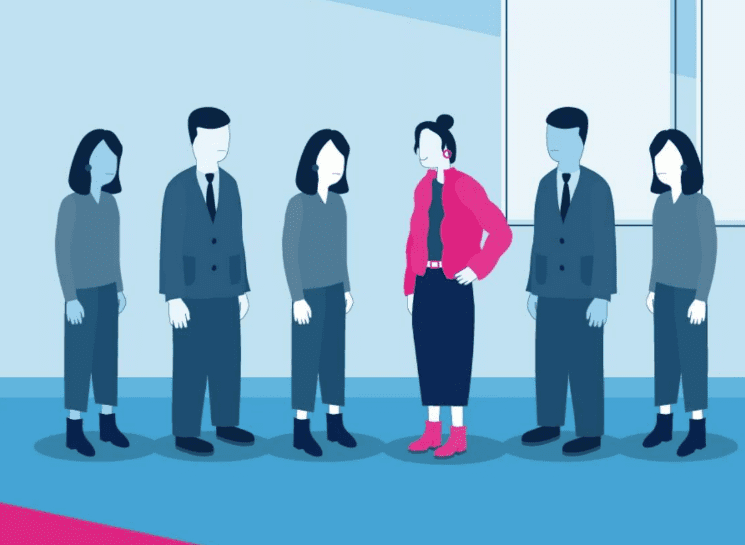
How to bridge this cross-generational skill gap with collaborative learning:
Soft Skills Training for Teams →
- Emotional Intelligence
- Active Listening
- Stress Management
- Resiliency Training
Expert Strategies for Using Group Training to Close the Generational Skills Divide
Set Up an Intergenerational Learning Program
Although such dedicated programs are still a budding concept, some companies have already tapped into those to address the competency gap and promote workplace inclusion through cross-generational employee development.
John Hancock is one of them.
In 2019, Peter McManama, Senior Director of US Finance at John Hancock, initiated a cross-generational learning program at the company. To expand it later, he joined forces with the new employee resource group, GenNEXT, which aims “to bridge the gap between generations in the workplace through education, networking, and volunteerism.”

You can likewise launch one with custom training sessions for the whole team, developed and arranged by Outback according to your unique requirements and age-diverse needs.
Create a Safe and Inclusive Space with Supportive Atmosphere for Collaborative Training
Space + Tools
According to Nicolas Breedlove, CEO at PlaygroundEquipment.com, every cross-generational team must establish a psychologically safe and age-inclusive space for learning. He adds, “Such a training workspace should be adapted for everyone to learn safely and feel included, regardless of age. Ideally, it would be best to diversify learning methods and formats—digital and analog tools—and let your workers choose.”
For example:
It can be a traditional classroom-style hub for cross-generational team training in the office, much like this one at Cisco, which is occupied on “Learning Mondays.”
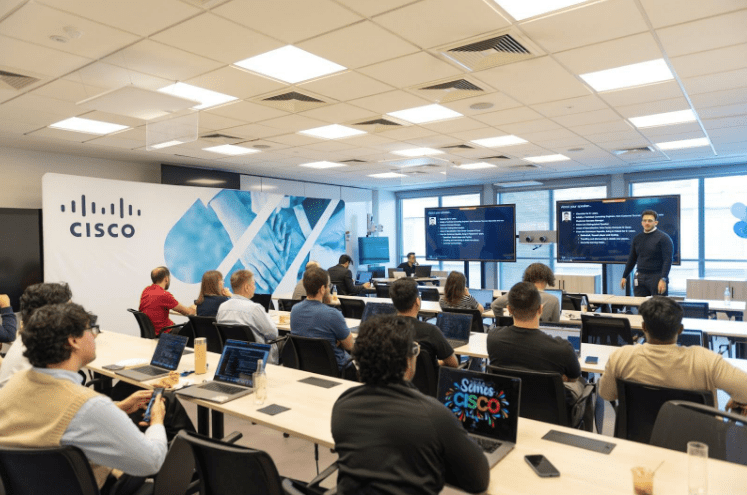
Alternatively, develop and grow professionally (and collaboratively!) in an online training center like Viva Learning by Microsoft.
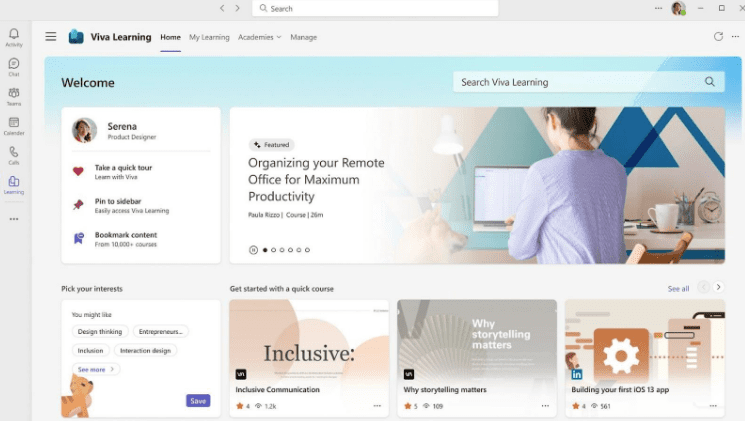
Atmosphere
Yet, whether you’re arranging it on-site or remotely, Anna Zhang, Head of Marketing at U7BUY, remarks, “A collaborative learning environment for a multigenerational team should be a healthy, no-judgment zone where employees feel free to express both professional and personal challenges. For instance, some team members may benefit from wellness or even debt relief programs to reduce financial stress and boost focus during training.”
Here are several healthy learning habits in this context:
- Normalize saying, “I don’t know” or “I don’t get it, please explain.”
- Speak age-inclusive language
- Respect each other’s learning pace
- Encourage and motivate each other all the way through training
- Exchange educational resources across generations
Brainstorm Appropriate Learning Activities Together
Look at the following ideas for a start and consider adding those to your multigenerational team building and development plan:
- Intergenerational Hackathon
- “Teach Each Other” Day
- Emoji/Meme Translation Game
- Myth-Busting Quiz or Trivia About Generations
- Historical Timeline Drawing
- Cross-Generational Book/Movie Club
For example:
How about a fast and fun team-building activity, such as asking your coworkers to explain Gen-Z slang and learning it together?
Afterward, you may publish a #funny-hashtagged video for employer branding on social media. See how the Diversifying.io team did that on TikTok, where this trend is extremely popular among companies.
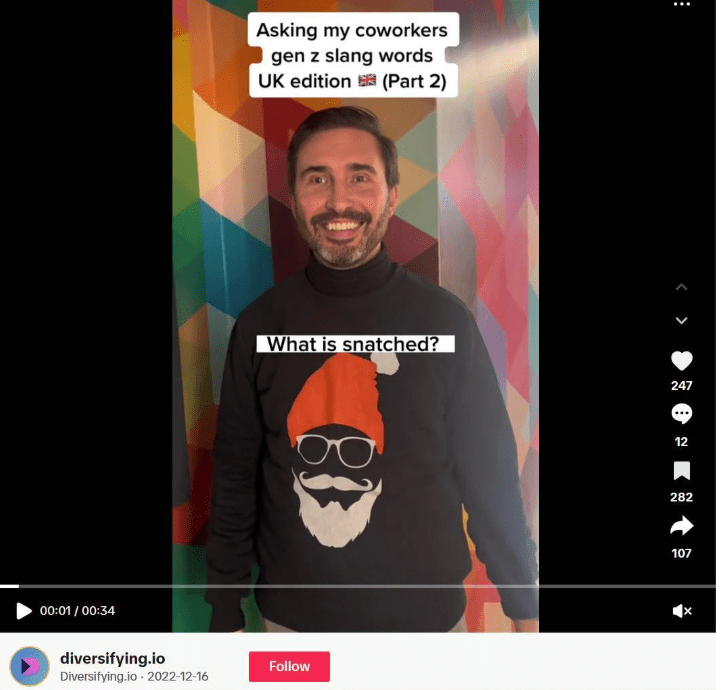
However, Adrian Iorga, Founder & President of 617 Boston Movers, notes, “You shouldn’t force cross-generational learning activities out of your team. Ask your team members what they prefer and make those voluntary, not mandatory. Anyway, it can be just a brief ask-me-anything chat to learn more about each other on the go if your work conditions permit.” Take, for instance, delivery or moving services.
Incorporate Reverse Mentorship into Your Training Routine
In contrast to a traditional mentorship format, reverse mentoring is a process when younger (typically junior) workers become mentors for their older (senior) colleagues.
For Josh Howarth, Co-Founder & CTO of Exploding Topics, it’s one of the best collaborative training strategies for bridging cross-generational skill gaps in teams. He forecasts, “Reverse mentorship is and will be a powerful driver of intergenerational learning in the future of work. New recruits or interns hopping on board today, tomorrow will be teaching their older peers in such aspects as social media trends or productivity tools, depending on the company’s needs.”
Let’s say you manage a team of property sellers. How can you implement reverse mentorship? Here’s how. Your Gen Z employees can train their senior coworkers on AR/VR home staging or using AI in real estate.
For example:
Coca-Cola Beverages Vietnam supports a reverse mentoring initiative with senior leaders taking up mentee roles.

Pair Age-Diverse Team Members to Communicate and Solve Problems
As a Gen Z-er operating in the C-Suite, Lacey Jarvis, COO at AAA State of Play, reveals, “Since the biggest age gap between my direct reports and me is about forty years, it’s crucial for us to understand why the others are thinking this particular way. It’s a learning curve. To find that out, we give enough space for everyone to talk and share ideas on how to cope with challenges. The more diverse, multigenerational perspectives = the smarter solutions and wiser decisions.”
For that, you may get age-diverse employees into groups or pairs for problem-solving activities as a part of your team-building strategy:
- Escape Room
- Crisis Response Simulation
- Clue Murder Mystery
- Zero-Capital Business-Starting Challenge
- Co-Creation Project or Building Exercise: Marshmallow Tower, Cardboard Boat, or Bridge Builders
For example:
With Outback’s assistance, T-Mobile planned and held a fun and collaborative Code Break activity with puzzles and other brainteasers to bring out their cross-generational wits and strengths and bond more tightly.
Build a Learning Bridge Between Employee Generations with Outback
It’s time to gather Boomers, Gen X, Millennials, and Gen Z workers under one roof (or e-roof, if virtually) to learn and grow side by side and make age diversity your team’s superpower. Contact Outback—they’ve got everything for your next corporate training or team-building bridge.
Author Bio
Catherine Schwartz is an author who specializes in employee well-being and engagement.

